Welcome to photo history - General of Tonle Sap Lake !
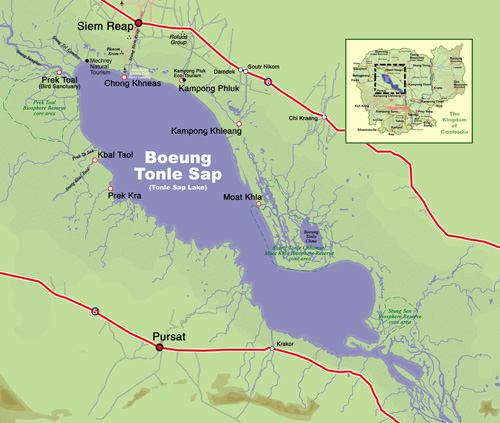 Cambodia's Great Lake, the Boeung Tonle Sap (Tonle Sap Lake,) is the most prominent feature on the map of Cambodia - a huge dumbbell-shaped body of water stretching across the northwest section of the country. In the wet season, the Tonle Sap Lake is one of the largest freshwater lakes in Asia, swelling to an expansive 12,000 km2. During the dry half of the year the Lake shrinks to as small as 2500 km2, draining into the Tonle Sap River, which meanders southeast, eventually merging with the Mekong River at the 'chaktomuk' confluence of rivers opposite Phnom Penh. But during the wet season a unique hydrologic phenomenon causes the river to reverse direction, filling the lake instead of draining it. The engine of this phenomenon is the Mekong River, which becomes bloated with snow melt and runoff from the monsoon rains in the wet season. The swollen Mekong backs up into the Tonle Sap River at the point where the rivers meet at the 'chaktomuk' confluence, forcing the waters of the Tonle Sap River back upriver into the lake. The inflow expands the surface area of lake more than five-fold, inundating the surrounding forested floodplain and supporting an extraordinarily rich and diverse eco-system. More than 100 varieties of waterbirds including several threatened and endangered species, over 200 species of fish, as well as crocodiles, turtles, macaques, otter and other wildlife inhabit the inundated mangrove forests. The Lake is also an important commercial resource, providing more than half of the fish consumed in Cambodia. In harmony with the specialized ecosystems, the human occupations at the edges of the lake is similarly distinctive - floating villages, towering stilted houses, huge fish traps, and an economy and way of life deeply intertwined with the lake, the fish, the wildlife and the cycles of rising and falling waters.
Cambodia's Great Lake, the Boeung Tonle Sap (Tonle Sap Lake,) is the most prominent feature on the map of Cambodia - a huge dumbbell-shaped body of water stretching across the northwest section of the country. In the wet season, the Tonle Sap Lake is one of the largest freshwater lakes in Asia, swelling to an expansive 12,000 km2. During the dry half of the year the Lake shrinks to as small as 2500 km2, draining into the Tonle Sap River, which meanders southeast, eventually merging with the Mekong River at the 'chaktomuk' confluence of rivers opposite Phnom Penh. But during the wet season a unique hydrologic phenomenon causes the river to reverse direction, filling the lake instead of draining it. The engine of this phenomenon is the Mekong River, which becomes bloated with snow melt and runoff from the monsoon rains in the wet season. The swollen Mekong backs up into the Tonle Sap River at the point where the rivers meet at the 'chaktomuk' confluence, forcing the waters of the Tonle Sap River back upriver into the lake. The inflow expands the surface area of lake more than five-fold, inundating the surrounding forested floodplain and supporting an extraordinarily rich and diverse eco-system. More than 100 varieties of waterbirds including several threatened and endangered species, over 200 species of fish, as well as crocodiles, turtles, macaques, otter and other wildlife inhabit the inundated mangrove forests. The Lake is also an important commercial resource, providing more than half of the fish consumed in Cambodia. In harmony with the specialized ecosystems, the human occupations at the edges of the lake is similarly distinctive - floating villages, towering stilted houses, huge fish traps, and an economy and way of life deeply intertwined with the lake, the fish, the wildlife and the cycles of rising and falling waters.
The lake sits only about 15 km south of Siem Reap town. If you take the ferry between Phnom Penh and Siem Reap you will cross the lake and dock at the village of Chong Khneas. There are several ways to see the culture and wildlife of the lake area depending on the amount of time you have and your interest.
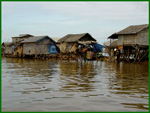 Chong Khneas
Chong Khneas
Chong Khneas is the floating village at the edge of the lake closest and most accessible to Siem Reap. If you want a relatively quick and easy look at the Tonle Sap, boat tours of Chong Khneas are available, departing from the Chong Khneas boat docks all day long. Take a motodup or taxi the 11-15km from Siem Reap to the boat docks where there are always boats waiting for passengers. A two-hour boat trip through the floating village runs $6 and the boats may carry as many as 15 other people. The boatman will probably point out the differing Khmer and Vietnamese floating households and the floating markets, clinics, schools and other boatloads of tourists. Chong Khneas, while interesting, is over-touristed and is not as picturesque and 'unspoiled' as floating villages further from Siem Reap. The boat trip usually includes two stops: one at a touristy floating 'fish and bird exhibition' with a souvenir and snack shop, and the other at the very highly recommended Gecko Environment Centre, which offers displays and information introducing the ecology and biodiversity of the lake area.
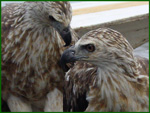 Prek Toal Bird Sanctuary
Prek Toal Bird Sanctuary
The 'bird sanctuary' at the Prek Toal core area of the Tonle Sap Biosphere Reserve has been called "the single most important breeding ground in Southeast Asia for globally threatened large waterbirds." The Biosphere covers 31,282 hectares at the northwest tip of the Tonle Sap Lake and plays host to species including Greater and Lesser Adjuncts, Black-headed Ibis, Painted Stork, Milky Stork, Spot-billed Pelican, Grey-Headed Fish Eagle and many more species. Of the three Biosphere core areas on the Tonle Sap Lake, Prek Toal is the most accessible from Siem Reap and the most popular with birdwatchers. The best time of year for viewing is the dry season when flocks of migratory birds congregate at Prek Toal. As the dry season progresses and the water recedes, the number of birds increases but the travel to some of the more important viewing areas becomes more difficult.
Most people arrange a trip to Prek Toal through their guesthouse or a tour operator. To do it yourself, take a moto or taxi from Siem Reap to the Phnom Krom/Chong Khneas boat dock. Arrange a boat to the Prek Toal Environmental Research Station (starting at $35-$45 return,) and then from the Research Station a $5 entrance fee and $15-$25 for a guided boat tour of the sanctuary. The Research Station has information on the area's flora and fauna. There are also basic overnight accommodations at the Research Station if you want to stay the night to take full advantage of the sunset and early morning viewing hours.
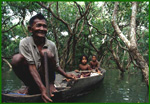 Kampong Phluk
Kampong Phluk
Kampong Phluk is a cluster of three villages of stilted houses built within the floodplain about 16 km southeast of Siem Reap. The villages are primarily Khmer and have about 3000 inhabitants between them. Flooded mangrove forest surrounds the area and is home to a variety of wildlife including crab-eating macaques. During the dry season when the lake is low, the buildings in the villages seem to soar atop their 6-meter stilts exposed by the lack of water. At this time of year many of the villagers move out onto the lake and build temporary houses. In the wet season when water level rises, the villagers move back to their permanent houses on the floodplain, the stilts now hidden under the water. Kampong Phluk's economy is, as one might expect, based in fishing, primary in shrimp harvesting.
Kampong Phluk sees comparatively few foreign visitors and offers a close look at the submerged forest and lakeside village life. The area can be reached by boat from the Chong Khneas or by road. Make arrangements through your guesthouse of tour operator, or charter a boat at the Chong Khneas docks. During the wet season, drive to Roluos village just off Route #6 east of Siem Reap and then take a boat through the flooded forest the rest of the way. During the dry season the road is clear, making the boat unnecessary. Much of the road has recently been improved, now paved most of the way.
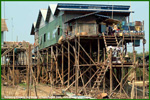 Kampong Khleang
Kampong Khleang
Kampong Khleang is located on the northern lake-edge about 35 km east of Siem Reap town, more remote and less touristed than Kampong Phluk. Visitors to Kampong Khleang during the dry season are universally awestruck by the forest of stilted houses rising up to 10 meters in the air. In the wet season the waters rise to within one or two meters of the buildings. Like Kampong Phluk, Kampong Khleang is a permanent community within the floodplain of the Lake, with an economy based in fishing and surrounded by flooded forest. But Kampong Khleang is significantly larger with near 10 times the population of Kampong Phluk, making it the largest community on the Lake.
The area can be reached by boat from the Chong Khneas docks or by a combination of road to Domdek on Route #6 and then boat to the village, the best method depending on the time of year. During the dry season, boats cannot get all of the way to the main villages. Consult your guesthouse or tour operator about current conditions. Many tour operators have very little experience in this area so it is best to consult with adventure tour operators and guesthouses that specialize in this area. Small group tours begin at about $35 for a half day and range up through $70 depending on the size of the group and the type of tour. To get there yourself, either charter a boat from Chong Khneas or take car or moto to Domdek village on Route #6 east of Siem Reap, turn south and continue to the water's edge where boats wait to ferry passengers into the village. During the dry season the road is clear and you can take a car or moto all of the way to the village.)
For bookings, please e-mail us with your arrival information:
Every page there is a BOOK A TOUR TODAY button that it's a simple process and is totally secured.
For any detail about our privacy please read here for the Term & Condition
Address: Mondul 3 Village, Siem Reap City, Siem Reap Province, Cambodia
Phone: +855 12 592 752 +855 93 863 051WhatApp ID: +855 93 863 051
WeChat ID: A093 863 051For inquiries or tour reservations please email us at :
angkorwatdriversovann@gmail.com Thank you & we look forward to seeing you soon !